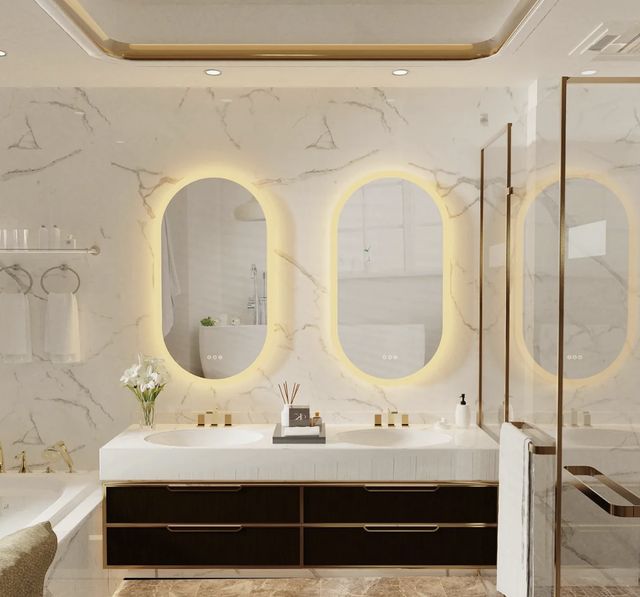DIY Installation Guide: How to Install a Bathroom Mirror with Lights
- Category: Pics |
- 25 Jun, 2024 |
- Views: 479 |

Installing a bathroom mirror with lights can seem like a daunting task, but with the right tools and guidance, you can achieve a professional-looking installation on your own. This step-by-step guide will walk you through the process, covering necessary tools, safety precautions, and troubleshooting tips for common issues. By following these instructions, you can enhance your bathroom with a stylish and functional lighted mirror.
Tools and Materials You’ll Need
Before you start, gather all the necessary tools and materials to ensure a smooth installation process:
• Bathroom mirror with built-in lights
• Measuring tape
• Pencil
• Level
• Drill and drill bits
• Screwdriver
• Wall anchors and screws
• Stud finder
• Electrical tape
• Wire nuts
• Ladder or step stool
• Safety glasses
• Gloves
• Voltage tester
Safety Precautions
Safety is paramount when working with electrical components. Follow these precautions to ensure a safe installation:
1. Turn Off Power: Always turn off the power at the circuit breaker before starting any electrical work. Use a voltage tester to verify that the power is off at the installation site.
2. Wear Safety Gear: Use safety glasses and gloves to protect yourself from debris and sharp edges.
3. Follow Manufacturer’s Instructions: Refer to the mirror’s installation manual for specific instructions and safety guidelines provided by the manufacturer.
Step-by-Step Installation Guide
Step 1: Plan the Placement
1. Measure the Wall Space: Determine where you want to install the mirror and measure the available wall space. Ensure that the mirror fits comfortably without obstructing other fixtures.
2. Mark the Position: Use a pencil to mark the top and bottom edges of the mirror on the wall. This will help you align the mirror during installation.
3. Locate the Studs: Use a stud finder to locate the studs in the wall. Mark the positions of the studs with a pencil. Anchoring the mirror to studs provides additional support.
Step 2: Prepare the Wall
1. Drill Pilot Holes: If the mirror’s mounting bracket requires screws, drill pilot holes at the marked stud locations. For additional support, you can also use wall anchors in the drywall.
2. Install Wall Anchors: If necessary, insert wall anchors into the pilot holes. Use a hammer to gently tap them into place.
Step 3: Mount the Bracket
3. Align the Bracket: Hold the mirror’s mounting bracket against the wall, aligning it with the pilot holes or wall anchors. Use a level to ensure the bracket is straight.
4. Secure the Bracket: Insert screws through the bracket into the wall anchors or studs. Tighten the screws securely using a screwdriver. Double-check that the bracket is level and firmly attached.
Step 4: Prepare the Electrical Connections
1. Turn Off Power: Verify that the power is still off at the circuit breaker.
2. Expose the Wires: Carefully strip the insulation from the ends of the electrical wires using wire strippers. This will expose about 1/2 inch of bare wire.
3. Connect the Wires: Match the wires from the mirror to the corresponding wires in the wall (typically black to black, white to white, and green or bare to ground). Twist the wire ends together and secure them with wire nuts. Wrap electrical tape around the connections for added safety.
Step 5: Mount the Mirror
1. Attach the Mirror: With the help of another person, lift the mirror and align it with the mounting bracket. Follow the manufacturer’s instructions for attaching the mirror to the bracket. This may involve hooking the mirror onto the bracket or securing it with additional screws.
2. Check Alignment: Ensure the mirror is level and properly aligned. Make any necessary adjustments before fully securing it in place.
Step 6: Test the Lights
1. Restore Power: Turn the power back on at the circuit breaker.
2. Test the Lights: Turn on the mirror’s lights using the built-in switch or touch controls. Verify that the lights are functioning correctly and that all connections are secure.
Troubleshooting Common Issues
Lights Not Turning On:
• Check Power Supply: Ensure that the circuit breaker is turned on and that there is power to the outlet or wiring.
• Verify Connections: Double-check all wire connections to ensure they are secure and correctly matched.
• Inspect Bulbs: If the mirror uses replaceable bulbs, ensure they are properly installed and not burnt out.
Mirror Not Level:
• Adjust Bracket: Loosen the screws on the mounting bracket and adjust it as needed to level the mirror.
• Use Shims: If necessary, use small shims behind the bracket to achieve a level installation.
Flickering Lights:
• Check Connections: Flickering lights may indicate loose or faulty connections. Recheck all wire connections and secure them tightly.
• Replace Bulbs: If the mirror uses replaceable bulbs, flickering may be due to a faulty bulb. Replace the bulb with a new one.
Anti-Fog Feature Not Working:
• Verify Power: Ensure that the anti-fog feature is receiving power and that the switch is turned on.
• Check Settings: Some mirrors have adjustable settings for the anti-fog feature. Refer to the manufacturer’s instructions for troubleshooting.
Conclusion
Installing a bathroom mirror with built-in lights can enhance both the functionality and aesthetics of your bathroom. By following this step-by-step guide, you can achieve a professional-looking installation and enjoy the benefits of improved lighting and modern design.
At LED Mirror World, we offer a wide range of high-quality bathroom mirrors with built-in lights, designed to meet your needs and preferences. Visit our store or website to explore our collection and find the perfect mirror to elevate your bathroom experience. With LED Mirror World, you can trust in the quality and innovation of our products to bring both convenience and style to your home.

